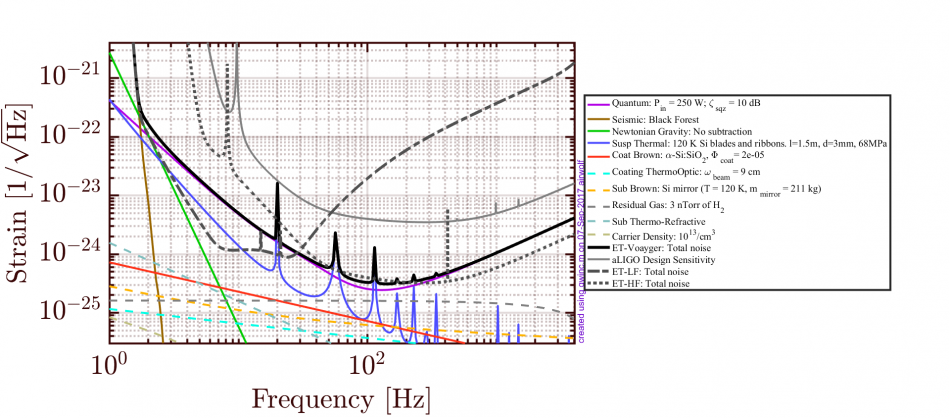Xylophone Congiguration
(Stefan, Benno, Bryan, Andrew, Sean, Marina)
Motivation
Why xylophone
- Concept proposed to avoid conflict between high frequency and low frequency design compromises (high/low optical power, thermal, quantum noise, etc)
Question: Do we still need the xylophone?
- Can we now do high power etc without being limited at low frequencies (Voyager design) Should we adapt this design, what are the problems with it, or should we stick with the xylophone?
- What do we lose if we abandon the xylophone?
- How much do we save?
Possible Tasks:
- Modify Voyager GWINC to ET parameters and compare to ET sensitivity
- Look for problems with this design.
LIGO Voyager GWINC model
GWINC files for Voyager,CE, … at https://dcc.ligo.org/LIGO-T1500293
The GWINC model can be found on git.ligo (link). Download from the whole repositry and run the BlueBird5.m file to recreate the Voyager Blue design sensitivity plot from the LIGO Voyager Design Concept document (DCC link) change parameters in IFOModel_123_2000.m or IFOModel_120_1550.m
Infrastucture
The interferometer model file was modified to reflect the infrastucture of ET.
Parameters changed:
- Arm Length 4km → 10km
- ETM, ITM ROC 5580m
- Gravity gradient noise (based on Black Forest measurement)
- Laser power up to 250W
- Photodiode efficiency for 1550nm 98%
Seismic and Newtownian Noise
The site seismic paramters were modified to approximate the potential ET sites. Numbers were based off the Black Forest study.
Squeezing
Within the GWINC model we included frequency dependent squeezing. To compensate for the change in cavity length and optical power the filter cavity parameters had to be tuned. This was intially done for 10dB of squeezing.
Paramters changed:
- Filter cavity detuning
- Filter cavity input mirror transmission
The filter cavities bandwidth was reduced by decreasing the input transmission by a factor of 4 and the cavity was detuned by +10deg, this roughy optimised the broadband quantum noise reduction.
Suspension Thermal Noise
Task: Use model of the suspension thermal nosie for ET design at 120K with 211kg test masses, developed by suspension working group. Include this in the GWINC model.
Sensitivity Implications
What do we lose by abandoning the xylophone
PRELIMINARY RESULTS:
- Lose the some LF sensitivty between 2-30Hz. At worst a factor of 6.
- Have roughly a factor of 2 less sensitivty at higher frequencies compaired to ET-HF (don't fully understand possible need to properly optermise the squeezing)
Suspension TN 120K 200kg 1.5m
Suspension thermal noise curves. For ET at 120K with 1.5m long final suspension stages and 211kg test mass.
Conervative estimate: 3mm diameter fibres, 69MPa:
More ambitious estimate: 1.5mm diameter fibres, 275MPa:
Summary/Conclusions
Our aim over the course of the workshop was to produce a preliminary (*very* rough) plot pulling together the general LIGO Voyager design and the improved seismic/NN/suspension aspects of ET. Ultimately this should provide a framework/baseline from which to hang our principal question - what do we lose if we abandon the xylophone approach?
This is a first attempt at pulling several strands of a complex model together. We may have missed some elements in getting the assorted files spread across multiple directories (and written by several different people) together. We have not optimised the quantum noise performance. We have not touched the coating noise from the Voyager design. We have only considered the 120K 1550nm 200kg system so far.
If we believe the plot, there are some obvious points to note - firstly, we lose some sensitivity at the high end compared to ET-HF (factor ~2) and some at the low end (factor ~6) but with some small improvement in the bucket.
Secondly, we are limited by quantum noise across the whole band of interest… this suggests there’s quite a lot of scope to improve/optimise squeezing and filter cavity parameters etc.
We cannot stress enough - preliminary result only. Do not trust this!
Next Steps
Verify we’ve gotten everything into the model that should be there and that there aren’t any rookie errors. (in-group task, though anyone is welcome to help)
Optimise quantum noise. (either tweak in-group or splice in the work from the quantum noise group)
Once happy check the other design options - 20K, 2000nm, etc. (in-group or anyone who’s interested)
Ultimately we’ll want a central IFO model that we all agree on and which can be used to calculate all the assorted noise contributions. (everyone)
